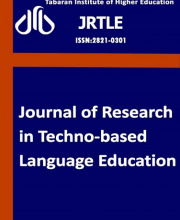۱.
کلید واژه ها:
Digital Formative Assessment Formative Assessment based on Mobile Learning (FAML) Spelling Achievement Technology Vocabulary Retention
Digital formative assessment was considered as using digital tools and technology to apply formative assessment in the EFL classrooms. Moreover, language learners’ vocabulary retention and spelling abilities are at the heart of language learning. Therefore, the present study examined the effects of digital formative assessment in improving Iranian pre-intermediate EFL learners’ spelling achievement and vocabulary retention in Mashhad. Fifty (N=25 male & N=25 female) pre-intermediate EFL learners into two groups took part in the study. The study was an experimental study with pre-test and post-test designs. The experimental group used the Spelling Bee application in contrast to the control group. This application could present corrected words to students when they did something wrong. Moreover, the teacher gave feedback to students during tasks. The control group did their tasks on the sheet and got feedback from the teacher. KET (Key English Test) test, vocabulary, and spelling test were used as the instruments of the study. At the beginning of the study vocabulary and spelling tests were presented as a pretest to participants in both groups. The participants answered the spelling and vocabulary tests as the post-tests. After the posttest, a delayed posttest was presented to assess vocabulary retention. The obtained results revealed that the use of the digital formative assessment had no significant effect on pre-intermediate Iranian EFL learners ’spelling achievement and vocabulary retention. Administrators, EFL teachers, and EFL language learners, can take advantage of the result of the present study.
۲.
کلید واژه ها:
Face-to-face Teaching L2 vocabulary learning Shaad Platform Mobile-assisted Learning EFL Learners
The perceived outbreak of COVID‐19 has forced the closure of schools in Iran. Alternatively, e-learning has emerged as a viable replacement for training students. The present study examined the comparative effects of applying Shaad as online learning versus face-to-face teaching on English as a Foreign Language (EFL) students’ vocabulary learning. To achieve this aim, sixty ninth-grade high school students were randomly selected. The members of the study were assigned to the Shaad and control groups. The instruments were a Cambridge Placement Test (CPT) and a researcher-made test administered as a pre-and post-test. First, the CPT was used, then a pre-test was administered to members of both groups. EFL learners’ vocabulary learning was analyzed at the end of the research; thus, the students in both groups performed the vocabulary post-test. Descriptive statistics and independent samples t-tests were run to determine the effect of Shaad on Iranian EFL learners’ vocabulary learning. The results revealed that teaching vocabulary through Shaad as online learning did not have a statistically significant effect on EFL students’ vocabulary learning. The results also showed a significant difference between the vocabulary learning of EFL students exposed to face-to-face teaching and those exposed to Shaad; thus, face-to-face learning is more effective. One of the study implications is that policymakers might provide infrastructure for virtual education to contribute to the improvement of EFL learning along with face-to-face education after the Covid-19 pandemic. Also, material designers can remove the deficiencies of the Shaad platform to develop the student’s vocabulary learning as an instructional aids tool.
۳.
کلید واژه ها:
Flipped Classroom High School Students online classroom Reading Comprehension
Flipped classrooms refer to teaching approaches that like usual teaching is not done inside the class. It means that before the class students watch videos that the teacher carefully chooses or prepared. The selected videos have to fulfill the required content that advances the abilities of the students in their learning. This study investigates the influence of online flipped classrooms on Iranian EFL high school students’ reading ability. To this aim, the study was done on 50 EFL 12th-grade and pre-intermediate level female students. The students were set into two groups experimental and control. A reading test was run on both groups as the pre-test, at the beginning of the study. Then, after 10 treatment sessions, the post-test was given to both groups. An independent samples t-test was run to compare the means. The outcomes illustrated the significant outperformance of the experimental group over the control group. In addition, to identify the EFL high school students’ attitudes toward the flipped classroom, the students were asked to answer an open-ended question. The results of students’ responses using thematic coding showed that most of the students had optimistic opinions regarding implementing the flipped classroom. Finally, the present study indicated that this model provides an opportunity for students to learn at their own pace and time. Therefore, it has some implications for teachers, students, and institutions which can increase student-teacher interaction in the teaching-learning process.
